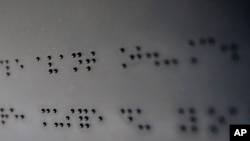A deaf and blind woman from the southern state of Victoria has become the first Australian to make a telephone call using a device that converts a conversation into Braille. It is part of a world-first trial that will test the technology in Australia and the United States.
With a simple phone call between two sisters, communications history has been made in Australia. Michelle Stevens, who is deaf and blind, says the braille telephone will end years of isolation. She’s one of five Australians who are taking part in a new trial that will run in parallel with testing in the United States, where the technology was developed.
Stevens' vision was damaged when she was born prematurely. Her hearing was lost because of serious ear infections.
She said the device will be of great benefit to her and others.
“This telephone system will be one way to break the isolation of deaf-blindness. Also, too, in time, with it further being developed I think we will be able to give more deaf-blind people opportunities to perhaps enter the workforce. That is a major barrier for employment for people who are deaf-blind is, you know, how are people going to be able to interact in the office on the telephone,” said Stevens.
The phones cost about $2,500. They work by transferring spoken words onto what is called a "dynamic braille display."
A parallel trial will also take place in the United States in the coming months.
Christopher Engelke, a director with U.S. firm Ultratec, which is running the trial in the United States, said it is an exciting project.
“The way that the whole system works is a deaf, or hard of hearing person, who speaks for themself, would use the phone just like any other phone, except that much like getting subtitles on your TV, you get sub-titles or captions to the conversation appearing on the screen, although for a Braille user they could read those captions in Braille bumps on a dynamic Braille display. So they would listen to as much as they can, speak with their own voice and then read everything that is being said to them by reading the Braille on the phone itself,” explained Engelke.
Developers say the device has the potential to change the lives of those who cannot see or hear. In Australia, it is estimated there are 330,000 people who are deaf and blind. Charities say that figure is likely to exceed 1.2 million by 2050.





